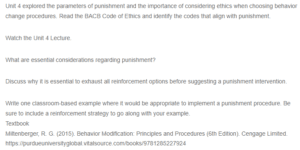Parameters of Punishment and Ethical Considerations
Teachers must understand the advantages and limitations of using punishment in class because schools often build aversive or punishing repercussions into plans to help control students’ behaviors. Accordingly, there are important considerations regarding punishment. First, punishment techniques are strong behavioral medicine and must be used with compassion and care (Shepherd & Linn, 2014). For instance, before a teacher punishes a student, they should consider whether a skill deficit causes the learner’s behavioral issues. Ethically, teachers should not punish students for behaviors they cannot help. For example, a chronically disorganized learner who frequently arrives late for classes without any writing materials might require to be taught organization skills instead of punishment.
Do you need an unpublished version of the “Parameters of Punishment and Ethical Considerations” ? Get in touch Our team of experts is ready to help.
Exhausting all the reinforcement options before suggesting any punishment intervention is essential. Besides, punishment, at times, is accompanied by considerable adverse effects. For instance, learners can drop positive attitudes towards school, leading to poor performance. Punishment can also make learners have more negative perceptions about tutors. Miltenberger (2015) insists that tutors adopt a more corrective way of interacting with young children, adults, and peers. Finally, physical punishment can cause predicaments in the learner’s mind, resulting in psychological issues like anxiety and fear that are linked to losing concentration and self-confidence.
A perfect classroom-based example is where a tutor instructs learners to be attentive and quiet to their teachings. While doing so, the learner will be honored to utilize the library for free. In such a case, positive reinforcement as a learning tool is highly effective as it is an approved way to improve school achievement (Miltenberger, 2015). Positive punishment is reprimanding a student to ensure the student does not converse with the deskmate while the teacher teaches. In this case, a stimulus is added to reduce the behavior. In negative punishment, a teacher eliminates a pleasant stimulus to decrease a behavior. For example, when a learner is on their phone and not paying attention, the tutor can snatch their mobile phone. In this scenario, a stimulus (mobile phone) is eliminated to reduce the learners’ conduct. Finally, immediate punishment is one means of decreasing unwanted behavior, and the learner may never repeat this behavior.
References
Miltenberger, R. G. (2015). Behavior Modification: Principles and Procedures (6th Edition). Cengage Limited. https://purdueuniversityglobal.vitalsource.com/books/9781285227924
Shepherd, T. L., & Linn, D. (2014). Behavior and Classroom Management in the Multicultural Classroom: Proactive, Active, and Reactive Strategies. SAGE Publications, Inc. (US). https://purdueuniversityglobal.vitalsource.com/books/9781483322131
ORDER A PLAGIARISM-FREE PAPER HERE
We’ll write everything from scratch
Question
Unit 4 explored the parameters of punishment and the importance of considering ethics when choosing behavior change procedures. Read the BACB Code of Ethics and identify the codes that align with punishment.

Parameters of Punishment and Ethical Considerations
Watch the Unit 4 Lecture.
What are essential considerations regarding punishment?
Discuss why it is essential to exhaust all reinforcement options before suggesting a punishment intervention.
Write one classroom-based example where it would be appropriate to implement a punishment procedure. Be sure to include a reinforcement strategy to go along with your example.
Textbook
Miltenberger, R. G. (2015). Behavior Modification: Principles and Procedures (6th Edition). Cengage Limited. https://purdueuniversityglobal.vitalsource.com/books/9781285227924


